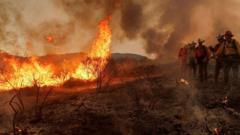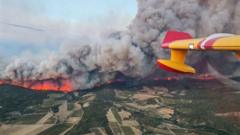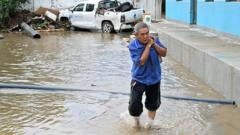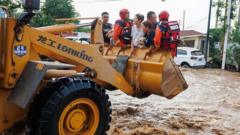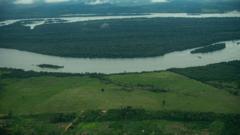Research published in JAMA indicates that the 2023 Los Angeles wildfires potentially resulted in approximately 440 indirect fatalities, vastly surpassing the official count of 31. With ongoing wildfires affecting air quality across North America, the findings emphasize the need for comprehensive tracking of both direct and indirect impacts of such disasters.
Study Reveals Over 400 Indirect Deaths Linked to LA Wildfires

Study Reveals Over 400 Indirect Deaths Linked to LA Wildfires
A new study estimates that wildfires in Los Angeles earlier this year may have caused over 400 additional deaths due to poor air quality and healthcare delays.
More than 400 indirect deaths are estimated to be associated with the wildfires that struck Los Angeles at the beginning of the year, according to recently published research. The study, which appears in the medical journal JAMA, reveals that the environment created by these wildfires exacerbated health conditions and delayed essential medical treatment, contributing to the staggering figure.
The official death toll from the Los Angeles County stands at just 31, marking the fatalities directly linked to the fires. This new analysis paints a much more somber picture by calculating the total deaths in the city during the wildfire period of January 5 to February 1, then comparing it to similar periods in previous years. The result showcases a troubling increase of nearly 7% in mortality during this timeframe.
Authorities attribute these additional deaths to various factors including respiratory and cardiovascular issues worsened by smoke exposure and stress, as well as medical interruptions for patients relying on treatments like dialysis and cancer care. The study stresses the importance of recognizing both direct and indirect fatalities when assessing the broader impacts of wildfire events and other climate emergencies.
In a related context, a different study published on the same day examined the aftermath of the devastating Maui wildfires. Researchers reported that 22% of adults in the area experienced diminished lung function, and nearly half showed signs of depression in the months following the August disaster, which resulted in over 100 fatalities and significant property loss.
Both studies underscore that the increasing frequency of wildfires, spurred by climate change, poses serious health risks, not only from direct flames but also through the hazardous smoke that can have long-lasting effects on lung health and cardiovascular issues. Vulnerable populations, including the elderly, children, and those with pre-existing conditions, are most at risk, although healthy individuals are not immune.
As ongoing wildfires continue to ravage parts of North America, including both the United States and Canada, experts urge for enhanced mortality surveillance and support systems to address the hidden toll of such catastrophic events.

